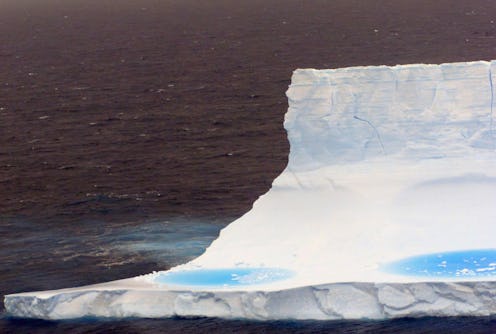News
Iceberg 6 Times The Size of Manhattan On The Loose
Watch out, guys — a freakishly large iceberg may be heading our way. The iceberg, which broke away from Antarctica's Pine Island Glacier in November last year, has been named B31 by NASA. It measures about 240 square miles in area, roughly six times the size of Manhattan. Now, NASA says the humongous iceberg is wandering into open oceans and could well be dangerous. Cue scary music.
For the past few months, NASA and the British Antarctic Survey have been able to monitor it via satellite and 37 GPS tracking units, respectively. The iceberg's original home, the Pine Island Glacier, is an ice stream located in West Antarctica. In recent years, the glacier's mass has rapidly shrunk and the speed of the stream has increased, which means it's also draining rapidly.
When B31 "calved" away from the glacier back in November, scientists weren't surprised. They had detected this all the way back in 2011. Still, they were cautious.
“Iceberg calving is a very normal process,” said Kelly Brunt, a glaciologist at NASA’s Goddard Space Flight Center, in a press release. “However, the detachment rift, or crack, that created this iceberg was well upstream of the 30-year average calving front of Pine Island Glacier, so this a region that warrants monitoring.”
Here are two photos that NASA's Earth Observatory took of B31 detaching itself from the glacier. The first one is dated Nov. 3, 2013. The second is dated Nov. 10, 2013.
As of April 11, 2014, B31 was still six times the size of Manhattan, according to the University of Sheffield's research team. The glacier has certainly loss some mass, but it still remains scarily huge.
So, what exactly is the danger of B31 drifting out into the Southern Ocean? Well, it can sink ships, and it can escape detection of radar of satellite. Between 1980 and 2005 alone, 57 vessels have had incidents with icebergs. In 2007, a Canadian cruise ship struck an iceberg and began sinking. Fortunately, all 154 people on board were rescued.
"Since there are more icebergs and they are melting faster, we can expect a bigger population of growlers and berg bits, so more danger to shipping," said Dr. Peter Wadhams to AccuWeather.
With that said, scientists appear to be more concerned about the Pine Island Glacier than B31. The main reason that B31 was able to drift out into the open ocean in the first place is because the glacier had thinned so much, as this video shows. The more the glacier drains and shrinks, the more risk there is of rising sea levels.
Images: NASA
